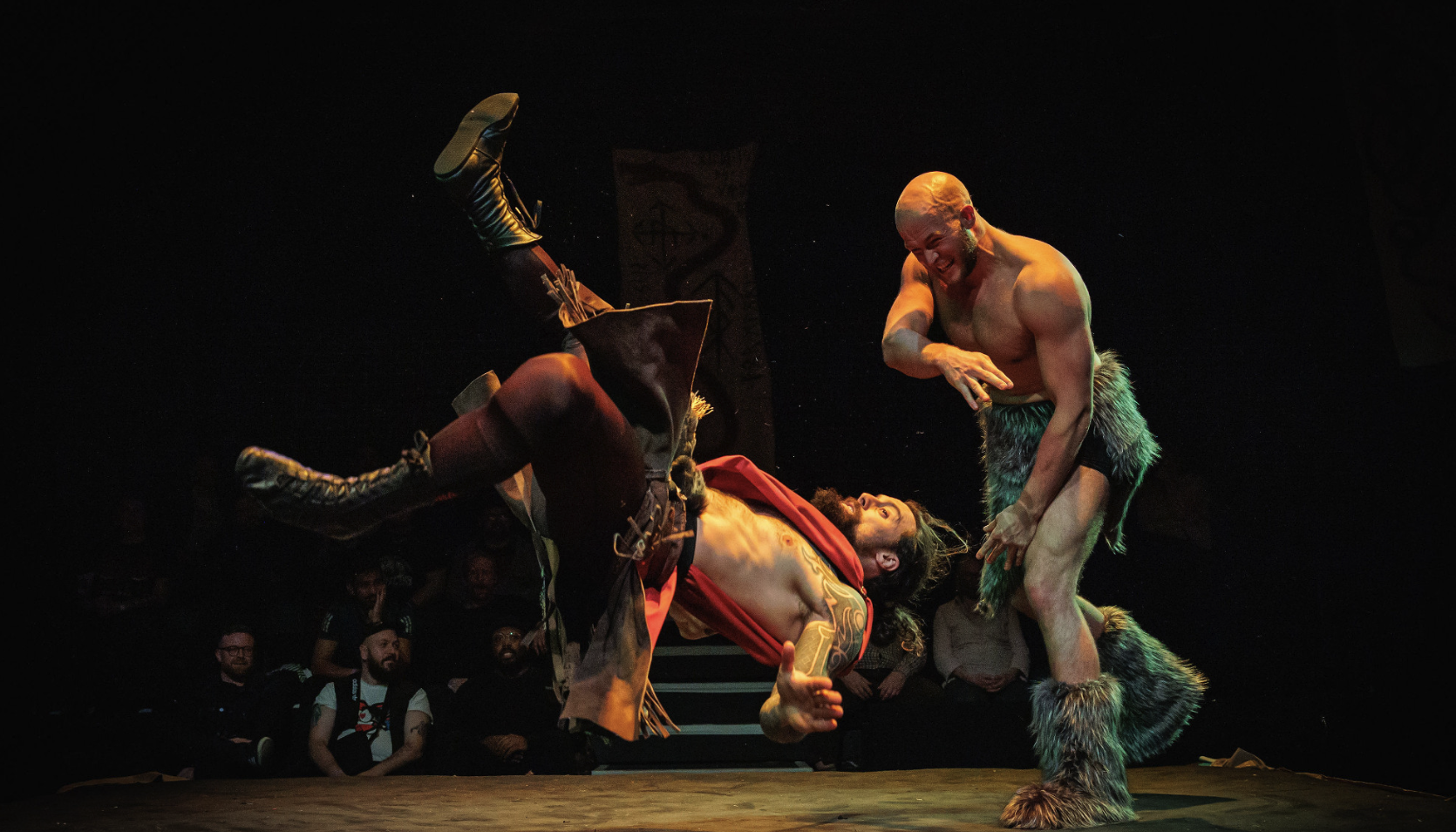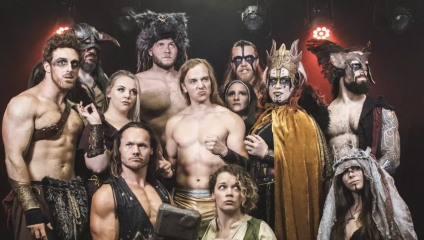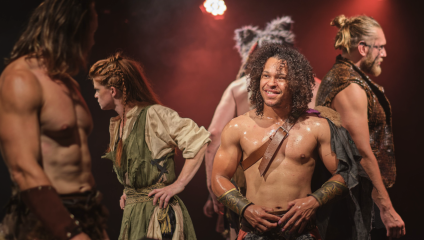Interview with Ed Gamester of Mythos: Ragnarök
Keen to peek into the chaotic worlds of Odin, Loki and Freyja? What about exploring Nordic myths reimagined as a modern dark comedy? Culture Calling took a look inside the mind of Ed Gamester, the creator of Mythos: Ragnarök, a modern-day epic of a show that is guaranteed to entertain...

Hi Ed, do you recall any myths or stories that captivated you when you were younger?
Absolutely! I delighted in series like Redwall, Swallows and Amazons and Goosebumps when I was about 8 years old, then discovered His Dark Materials and the Discworld series I was around 12. I fell in love with the heroic fantasies of David Gemmell when I was a teenager and developed a particular fascination for weird worlds, like The 13.5 Lives of Captain Bluebear. I don’t recall when I first came across mythology, but I could have recited any of dozen Greek myths or Norse sagas by the time I was 16 years old, by which point I’d started writing my own.
I was lucky enough to study ancient and classical history at school, and I found myself drawn to the ways in which story, religion and myth played such a huge part in ancient people’s everyday lives. People say myths and stories are an “escape” from reality, but for me they were always a guide for how to deal with it. As a child, I felt adoration and respect for characters who were physically capable and acted with courage and honour no matter the circumstances, and I felt sick with betrayal and disappointment whenever they were cowardly, selfish and cruel, or incapable of looking after other people.
As for many young people, stories helped me understand that being strong, honest and kind is something we have to choose and continue choosing. Once you have internalised those standards for yourself, you don’t need anyone else to hold you accountable because you understand who and what you’re choosing to be, and why. So yes, I’d definitely say myths and stories both captivated and entirely shaped who I have tried to become!

You’ve worked in a variety of roles from acting, wrestling, stunts performing, writing & producing; is there a common thread
It’s all storytelling, really: it’s all motivated by a desire to create, capture and express feelings and experiences in ways that allow me to share them with other people. As a writer that seems obvious, but as a stunt performer or a wrestler I can understand why people outside of the industry wouldn’t immediately spot the connection between fighting and storytelling.
Good fight scenes are plot devices: they advance the story and development of the characters as much as any other scene. You want people to care about the characters, be engrossed in the action and – by the end of the scene – feel elated, disappointed or relieved. That isn’t achieved by explosions and backflips: it’s achieved by creating relatable characters that people care about and putting them in believable situations with clearly defined stakes, where the audience genuinely cares about the outcome. Granted, as a stunt performer I rarely get much insight into the character history of Gangster Unloading Truck; my job is to get yanked by a cable into a brick wall and make it look as though the impact has killed me. Yet the motivation is the same: to be a small part of creating a situation, scene and sequence that will elicit a meaningful response from the viewer. The same is true of wrestling. Wrestling matches themselves are self-contained stories, wherein we meet the characters, understand their motivations and personalities, and follow them on their journey to victory or defeat.
Overcoming the monsters, rags to riches, comedy, tragedy – you can find clear examples of every storytelling type within specific wrestling matches. That’s even before you consider the plots that link the wrestling matches themselves together into a wider universe of intermingled stories, which give individual moves and moments deeper meaning. There’s an iconic moment in wrestling history when Mankind removes his mask in a confrontation with Triple H. To a casual viewer, it seems like simple intimidation. To somebody who understands the wider plot and universe, it’s clear that Triple H now has to overcome a much more intimidating challenge in the form of Cactus Jack. This one simple gesture raises the stakes enormously because it is based upon decades of character development and storytelling, which is something found very rarely outside of the wrestling industry.
All of this also explains why we have nostalgic memories of watching wrestling as children. It’s not because the actual wrestling or fighting was better (it was often worse), but because we were invested in the characters – either because the writing was better or because we ourselves were younger and more inclined to believe and become emotionally invested in what we were watching. Either way, my point is that no matter which industry I have worked in, the intended outcome has always been the same: to tell stories either by creating the whole thing from scratch, or by simply creating an individual meaningful moment within a greater plot.
With over 100 performances under its belt, how has Mythos: Ragnarök evolved over time?
It’s leaner and meaner these days. The first show we did was 120 minutes long, now it’s only 90 minutes and the Fringe version is just 70 mins! At the same time, the funny parts are snappier, the sad parts are deeper and the violent parts are more impactful – in short, we do more with less and that makes it a wild ride for both us and the audience.
The production and direction of the show improves every time, too: the costumes and tech are always evolving and improving and we’re improving as actors and performers, because for many of us this is our first time in a theatre show. A lot of what we do on stage is contrary to our instincts as professional wrestlers, so there’s as much unlearning of old stuff as there is learning of new.
People don’t realise this, but Mythos: Ragnarok was never rehearsed. I wrote it, we learned it and we ran the lines a few times, but the only times we ever did the show the whole way through was live: it took us dozens of performances to even get to the point where most shows start!
The people who watched us at Edinburgh Fringe 2022 truly witnessed a work in progress and live development of a show: the fact that we went from one person in the audience to nightly sell-outs within two weeks is a tribute to how hard everybody worked to bring it together.

How has comedy been weaved into the production; are there inspirational actors, books, performances that you’ve looked to in
Let’s be clear: I’m a philistine. There was no education, inspiration or traditional process to the creation of my show; it was an outpouring of my love for these stories and desire to tell my own version, based on what I personally find funny, weird, disturbing or confusing. I didn’t need to weave comedy into the myths: it’s right there in the stories and characters – all I did was present my own spin on my favourite elements.
I’ve read versions of the myths that I’ve found more or less funny and inspiring than others, but for me they’ve all lacked something vital. When creating my version of the myths, therefore, it was important to me that it was respectful and true to the ancient stories, because I think modern versions are often over-sanitised for fear of offending our sensibilities.
At the same time, I wanted to make sure it was engaging for audiences who are excited, interested or amused by different aspects of the tales than our ancestors were. I know my way of doings things isn’t the right way to go about creating theatre, but I also believe we live in a time where too many people create what they think they’re meant to create or what they think will sell, and too few people create something simply because they adore it and need to bring it to life.
How can Norse myths help us live better, more enjoyable or more exciting lives in the 21st century?
Gods are often portrayed as all-powerful and immortal beings who aren’t affected by mortal worries. This makes them easy to fear and worship, but difficult to relate to: they aren’t born, they won’t die, and they don’t have to struggle to develop skills or make difficult decisions about what to do with their time.
The Norse Gods, by contrast, are flawed and mortal and all-toohuman. Just like us, their time is short, their deaths are inevitable, their strengths are limited and their weaknesses are many. Their trials and struggles reflect ours, which makes their stories much more entertaining and relatable: there is always something to be learned from the way the Norse Gods go about overcoming their challenges. Rather than praying for assistance or waiting for help from a higher power, the Norse myths encourage us to face life’s difficulties by striving to live up to role-models embodied by the Gods.
Equally, they teach us to go easy on ourselves for falling short or failing, because the Gods aren’t perfect either. There is also fatalistic glory to the Norse myths. The Gods know they are doomed to perish at Ragnarok, yet they ride out proudly to meet it anyway. They don’t waste their short time trying to avoid the inevitable: their stories teach us to embrace our mortality and temporary nature, and enjoy the time we have rather than fearing the end.
Learn more about Mythos: Ragnarök